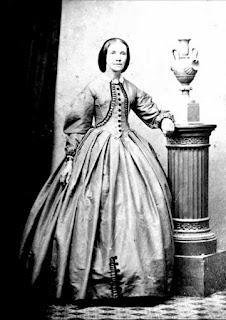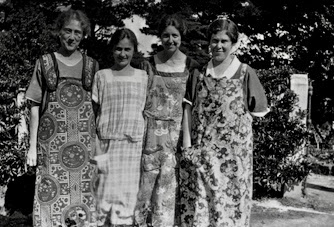7/52 Landed : Anne Stevens
6/52 Landed: Ann Stevens
I knew hardly anything about Ann Stevens, my 3x great grandmother. According to her 1875 death notice in the Adelaide papers, she was born in 1802, aged 73 when she died. But she was 35 in 1841 according to the Census, so born in 1806. Possibly she didn’t know exactly how old she was.
Her marriage certificate to Thomas Hobbs in 1830 says that she was from Rushall, which is a tiny village near North Newnton and Hillcott, Wiltshire, where she and Thomas lived and raised their children before they came to Australia. She could sign her name but Thomas signed with a cross. He never learned to write.
In 2019 on a hot day in June, I caught the train from London to Pewsey, the bus to North Newnton and walked the road to Hilcott. There are still old farm houses with thatched roofs and I even saw a thatcher working on replacing the thatch. The road follows the creek, lush, green grass, hedgerows, fields of corn, lowing Hereford cattle.
In 1841 the population of North Newnton/Hilcott was 262. I didn’t see anyone at all, except at the church when a woman came to do the flowers, and the thatcher, up on the roof.
It was the Anglican church where no doubt Ann and Thomas got married, where they had been baptised and their parents buried. I walked to a house which, according to the woman at the church, had been the Methodist chapel, but since then I’ve learned it opened three years after Ann and Thomas left Wiltshire.There must have been a sizeable community in the years leading up to 1852 though to justify the establishment of a chapel. Given the Australian Hobbs’ family’s commitment to Methodist my guess is they were members in Hilcott, worshipping in a farmer’s barn, like they did in the TV show, Poldark.
The sign on the pub, the Woodbridge Inn, near the bus stop in North Newnton reads: ’For centuries the social landscape remained substantially unchanged, until enclosures, new farming technology, and economic volatility drastically reduced agricultural wages and threatened farmworkers livelihoods. The Vale was a prominent location of the Swing Riots of 1830.’ This was the social and political environment in which the Hobbs raised their four children: Charlotte, (1833) Jonah, (1836) Sally (1839) and Jane (1844) (Sally is officially ‘Sarah’ but Thomas calls her ‘Sally’ in his will so that is what I am calling her here). In the 1841 census Thomas was listed as an ‘Ag lab’- an agricultural labourer. They were by no means ‘landed’.
Ann, aged 47, and Thomas, 40, and the four children, Charlotte, 16, Jonah, 13, Sally, 10 and Jane 5, left Wiltshire and boarded the Harry Lorrequer, leaving from Plymouth on 22nd September, 1849. There were 359 emigrants on board: almost equal numbers of men (102) and women (100), of whom there were 64 married couples, one hundred and nineteen children under 14 and thirty eight young people with their parents between the ages of 14 and 20.. Of the men, roughly 70% were, like Thomas, agricultural labourers. The Hobbs were the only family from Wiltshire.
Their assisted passage subsidised their tickets. It still cost a bit: £2 if you were under 40 (for Charlotte) and £6 x 2 (for Ann and Thomas) if you were under 50. All children under 14 had to pay £1 each. Jonah, Sally and Jane. It comes to £17. Not a small amount. Ag labs, shepherds and domestic servants paid less than blacksmiths, miners and wheelwrights. Needlewomen paid more than domestic servants. Out of this payment the ‘commissioners’ paid for bedding and eating utensils. This had to be paid before an embarkation order was issued.
They arrived in Port Adelaide on Boxing Day, 1849. Did they breath in the smell of eucalyptus and smile to hear the laugh of a kookaburra for the first time? On arrival the Emigration Agent came on board the ship to examine the ‘condition and discipline’ of the passengers and to offer guidance. It was eight miles to Adelaide and help was available to get you there if you were destitute. There were also cottages in Port Adelaide where you could stay while you waited to get a job, or you could stay on board ship for up to two weeks. The ‘Colonial Labour Office’ was opposite the Post Office in King William Street, like a nineteenth century Job Centre, except that there was plenty of jobs! Wages were high and food was cheap.
Before 1836 the Adelaide plains had been the land of the Kaurna people who had a complex society dependent on the rich resources of what they knew as Tarntanya - place of the red kangaroo. By the time Ann and her family arrived there were few of the original land owners still camping in the Adelaide plains, although there may have been a ‘fringe’ camp in Port Adelaide. There weren’t too many red kangaroo bounding across the plain either. Their land had been subdivided and sold to colonists, fenced and built on. Did the Hobbs encounter Kaurna people and what were their feelings about their dispossession?
My cousin Ian Hobbs and I are both descended from Jonah, the teenage boy who first gazed across the flat, hot, brown land from the deck of the Harry Lorrequer. According to Ian’s research, Thomas got work as an agricultural labourer in Marden, Payneham and Modbury. Jonah would have worked for wages alongside his father. He was sent to learn the gardening trade but in 1851, aged 16, he took off to the Victorian Gold fields, perhaps to see if there was a quicker way to riches. He found there wasn’t and walked home to Adelaide.
Thomas took four years to save up enough money to buy his own land. It was in Marden, on the River Torrens, where still today stately river red gums spread their branches and drop their bark. There is a Wiltshire village called ‘Marden’ close to Hilcott. A Joseph Gilbert, who had named his vineyard in the Barossa Valley ‘Pewsey Vale,’ had bought the land on the Torrens in 1840, subdivided it into farming blocks, and named it Marden. We can assume that Mr Gilbert was a Wiltshire migrant from the same area as the Hobbs family. Thomas Hobbs’ land bordered James Harris’s land, where Jonah was employed after his trip to the gold fields. When Thomas bought land, Jonah went to work with his dad.
Jonah soon saved up enough to buy his own land, the other side of James Harris’ and now able to support a family, aged 19, he married Virtue Hill in the summer of 1855. She was from Wiltshire as well and had arrived in Adelaide the same year as Jonah. He built a cottage from river stones, with a cellar. The house, Rose Cottage, is still there. The current residents have located the cellar and are renovating it to keep wine, not something the Hobbs family would have approved. Jonah’s older sister, Charlotte also married in 1855.
Sadness follows joy. In 1855 Thomas died, aged 47, from ‘dropsy’. That is an old fashioned word for heart failure. I have some idea of what it was like for Ann, to live with someone with heart failure: my husband has it too. Thomas would have been slowly deteriorating for a long time. Today he could have been saved by diuretics, but in those days, he would have been breathless; his ankles and then his legs swollen with fluid. Ann, Jonah and the girls would have had to take on increasing manual labour on the land. He died on December 11th, just three days after he he had been presented with his first grandchild, Jonah’s baby, Arthur Hobbs.
Thomas’s will, written the day before he died, made two neighbouring gardeners the executors of his estate, James Harris being one. The house, land, the household furnishings were to be held in trust for the benefit of Ann, Sally and Jane. Following Ann’s death, after Jane turned twenty one, the property was to be sold and the proceeds divided evenly between the four children.
It was a hard time. Four months later Jonah and Virtue’s baby Arthur died from dysentery in April 1856, and in August, Virtue also died, from consumption. Jonah worked through his grief in the garden. He planted orchards on his own land and also his mother’s, which was just the other side of James Harris’s block. I imagine he walked along the bank of the river through the Harris land to get to Ann’s place. He would have been close to the Harris’s, who had been employers and neighbours from the beginning. James and Dinah Harris had migrated from Devon ten years earlier than the Hobbs and were Bible Christians, close to Methodists. A year later Jonah married Rebekah, their fourth daughter.
Ann came to Adelaide a landless agricultural labourer’s wife, mother of four children. After Thomas died, only five years after they arrived, she continued to live on the land he had bought for her. She lived there for another twenty years surrounded by her children and grandchildren. When Sally married in 1859, Ann and Jane lived together.with Jonah and Rebekah just down the road. Sally’s family also settled in Marden.
Rose Cottage, built by Jonah in 1855 where he and Rebekah raised their children.
Both Jonah and Sally gave her many grandchildren. Between the two of them, before Ann died , they had thirteen children but only 5 were still alive. Why did so many young children die? Infectious disease? Unsanitary conditions?
The youngest daughter Jane, postponed marriage but at 29 she finally did marry and had a baby girl in time to meet her grandmother.
Ann died in November, 1875, at her daughter’s place in Payneham. This daughter was probably Sally as she appears to have a Payneham address. Her husband had died five years before Ann, and Sally was left with three children under 9. I don’t know what happened to the oldest daughter Charlotte. Jonah became a rich man, a prominent orchardist and nurseryman, father of five. Jane outlived her three children and husband, dying at ninety five in 1939. But that is another story.
References
Church of England Marriages and Banns, Wiltshire, England, 1754 -1916
English Census. 1841, Wiltshire
Hobbs, Ian. Thomas Hobbs and Family, From Hilcott in Wiltshire to Adelaide, 1849, 2004. Self published.
https://adelaidia.history.sa.gov.au/subjects/kaurna-people
https://bound-for-south-australia.collections.slsa.sa.gov.au/
http://www.theshipslist.com/ships/australia/au1838.shtml
South Australia-Marriages 1842-1916
South Australian Register, Sat 27 Nov, 1875, p 4, family notices






How wonderful to have been able to go back "home" and see your ancestors' village. I have ancestors from Wiltshire too - the Case family who settled in NSW probably about the same time as your ancestors. I also have ancestors by the name of Nobbs who I thought were Hobbs there for a while. Writing!! Anyway, well done with your progress on the 52 Ancestors in 52 Weeks Sally :)
ReplyDeleteThank you Alex. It was quite an adventure going to Wiltshire! My sister wouldn’t come with me: she is bored by family history! It was very hot and I had to walk a long way on dodgy knees! And wait for ever for the bus. But now, in retrospect, it was fully worth it! I am powering on with 52/52 and the rest of my life is on hold!
ReplyDelete